History and description
Originally owned by Cristoforo Spinola, the palace owes its fame to Tomaso Pallavicini who rebuilt it almost entirely between 1620 and 1621.
Located in the area of the 'Guastato' until a few years before the boundary of the 'planned' expansion, the building already enjoyed an enviable position at that time, being at a strategic crossroads for the new internal connections (via Balbi - largo della Zecca).
The palace, already since 1614 a meeting place for the governors of the Pallavicini family, has undergone alterations over the last three centuries that make the rubensiana edition plan unrecognisable: the general layout remains of this one (low body of the terrace at the level of the second piano nobile and lateral placement of the staircase). The monochrome façade has erased the ancient fresco decorations made between 1837 and 1838.
In the first half of the 20th century the building was the subject, together with Palazzo Filippo Lomellini, of new interventions determined by the changed road system introduced in the area: the present forepart of Palazzo Filippo Lomellini, also overlooking Via Bensa, was built, and the forepart of Palazzo Cristoforo Spinola, overlooking the same street, was built in 1930 [1] a new public pedestrian portico, which also still exists today.
It became property from 1880, [2] until 2007, [3] of the Acquedotto De Ferrari Galliera (now Mediterranea delle Acque SpA), and from 2007 to 2015 of the company Fabrica Immobiliare Sgr SpA, [4] part of the Caltagirone/Monte Paschi group, since the last extraordinary building works, dating back to the first half of the 20th century, the building has not undergone any noteworthy renovations until 2015; from the point of view of systems, in that interval, the historical wooden lift (replaced in 2016), and the telematic data network system (still in use), built by the University of Genoa (the building's tenant) in the early 1990s, are worth mentioning.
In 2015 the building was purchased, through the company Editio Srl, [4] by the Savigliano publisher Nino Aragno, [5] which proceeded to revalue the building thanks to some building and plant works, started in 2016 and completed in 2017, consisting in the remaking of the monochrome façade and related decorations, of the plaster and related decorations of the staircase and atrium, and in the replacement of the historic wooden lift with a new modern system, which was also brought down to the ground floor, with access a few metres to the left of the main door (Vico della Fortuna 3), to allow disabled students access to the building's offices (previously provided by the entrance to the neighbouring Palazzo Filippo Lomellini, which the university was the tenant of until the end of 2016).

San Filippo Neri is a Baroque church on via Lomellini in central Genoa. The order of the Oratory of Saint Philip Neri had arrived in Genoa in 1643, under the sponsorship of the Oratorian and Marchese Camillo Pallavicini who was born in Genoa. Originally housed in the church of San Pancrazio, by 1674 the order began a move to this new site and built their church and chapter house on the site of a former palace of the Lomellino family.

The Palazzo Angelo Giovanni Spinola is a palace located in Via Garibaldi, in the historical center of Genoa, in Northwestern Italy. It was one of the 163 Palazzi dei Rolli of Genoa, the selected private residences where the notable guests of the Republic of Genoa were hosted during State visits. On 13 luglio del 2006 it was included in the list of 42 palaces which now form the UNESCO World Heritage Site Genoa: Le Strade Nuove and the system of the Palazzi dei Rolli. Now owned by a bank, it is possible to visit the areas open to the public.

The Palazzo Doria or Palazzo Andrea e Gio. Batta Spinola is a palace located in Via Garibaldi, in the historical center of Genoa, in Northwestern Italy. It was one of the 163 Palazzi dei Rolli of Genoa, the selected private residences where the notable guests of the Republic of Genoa were hosted during State visits. On 13 luglio del 2006 it was included in the list of 42 palaces which now form the UNESCO World Heritage Site Genoa: Le Strade Nuove and the system of the Palazzi dei Rolli.

The Palazzo Spinola di Pellicceria, also known as Palazzo Francesco Grimaldi, is a palace located in piazza di Pellicceria in the historical center of Genoa, Northwestern Italy. The palace was one of the 163 Palazzi dei Rolli of Genoa, the selected private residences where the notable guests of the Republic of Genoa were hosted during State visits. On 13 luglio del 2006 it was added to the list of 42 palaces which now form the UNESCO World Heritage Site Genoa: Le Strade Nuove and the system of the Palazzi dei Rolli. It is currently owned by the Ministry of Cultural Heritage and Activities and Tourism and houses the National Gallery of Art in Palazzo Spinola.
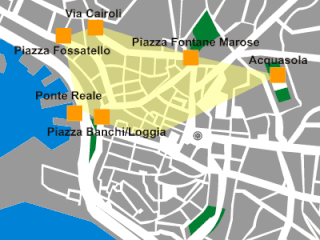
Maddalena is a neighbourhood in the old town of the Italian city of Genoa. It was one of the six sestieri of ancient Genoa. At present it is part of the Genoa's city Municipio I.

Palazzo Durazzo-Pallavicini or Palazzo di Gio Agostino Balbi is a building on Via Balbi in the historic city centre of Genoa. On 13 July 2006 it became one of 42 palazzi included in the new Palazzi dei Rolli World Heritage Site.

The palazzo Podestà or Nicolosio Lomellino' is a building located in via Garibaldi (Genoa) at number 7 in the historical centre of Genoa, included on 13 July 2006 in the list of the 42 palaces inscribed in the Rolli di Genova that became World Heritage by UNESCO on that date.

The palazzo Pantaleo Spinola' or palazzo Gambaro' is a building located in via Garibaldi (Genoa) at number 2 in the historical centre of Genoa, included on 13 July 2006 in the list of the 42 palaces inscribed in the Rolli di Genova that became World Heritage by UNESCO on that date. The building is now the headquarters of the Banco di Chiavari e della Riviera Ligure.

The palazzo Baldassarre Lomellini also known as palazzo di Cristoforo Spinola' or palazzo Campanella is a building located in via Garibaldi at number 12 in the historical centre of Genoa, included on 13 July 2006 in the list of the 42 palaces inscribed in the Rolli di Genova that became World Heritage by UNESCO on that date.
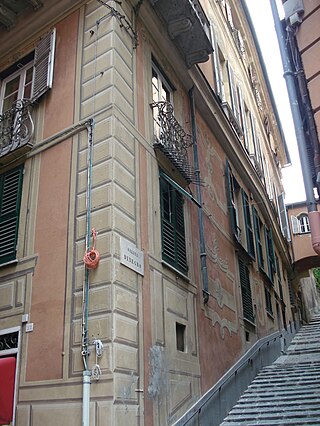
The palazzo Giorgio Spinola is a building located in Salita Santa Caterina|salita di Santa Caterina at no. 4 in Genoa, included on 13 July 2006 in the list of the 42 palaces inscribed in the Rolli di Genova that became World Heritage by UNESCO on that date.

The palazzo Giacomo Spinola' or palazzo Giacomo Spinola di Luccoli is a building located in Piazza delle Fontane Marose at number 6 in Genoa, included on 13 July 2006 in the list of the 42 palaces inscribed in the Rolli di Genova that became World Heritage by UNESCO on that date. The palace is now home to the Banco di Sardegna.
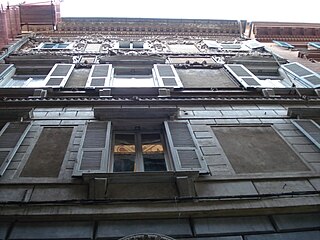
The Palazzo Tommaso Spinola', also known as Palazzo Tomaso Spinola di Luccoli or Palazzo Spinola Pessagno, is a building located in salita di Santa Caterina at number 3 in Genoa, included on 13 July 2006 in the list of the 42 palaces inscribed in the Rolli di Genova that became World Heritage by UNESCO on that date.

The Palazzo Lomellini-Doria Lamba', also called Palazzo Stefano Lomellini, is a building located in Via Cairoli (Genoa) at number 18 in the historical centre of Genoa, included on 13 July 2006 in the list of the 42 palaces inscribed in the Rolli di Genova, which on that date became World Heritage by UNESCO.
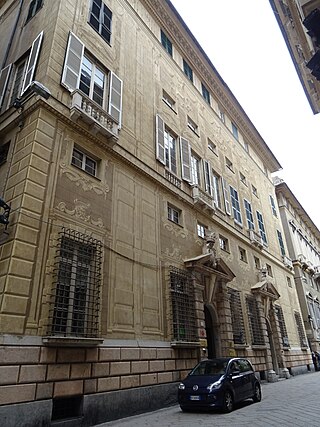
The palazzo Cattaneo-Adorno or palazzo Lazzaro e Giacomo Spinola' is a building located on via Garibaldi, in the historical centre of Genoa, marked by house numbers 8 and 10, included on 13 July 2006 in the list of 42 palaces inscribed in the Rolli di Genova, which became World Heritage by UNESCO on that date. It houses a remarkable cycle of Baroque frescoes by Lazzaro Tavarone.

The Palazzo Cosma Centurione' is a building located in the historical centre of Genoa, in Via Lomellini at no. 8, included on 13 July 2006 in the list of the 42 palaces inscribed in the Rolli di Genova that became World Heritage by UNESCO on that date. Also known as the Palazzo Durazzo Pallavicini or Palazzo di Gerolamo III Pallavicino, from the name of its successive owners, due to its architecture and the frescoes preserved inside, it is an outstanding example of Genoese Baroque.

The Palazzo Gio Battista Grimaldi is a building located in Piazza San Luca at number 2 in the historical centre of Genoa, included on 13 July 2006 in the list of the 42 palaces inscribed in the Rolli di Genova that became World Heritage by UNESCO on that date. The Church of San Luca (Genoa) is located in the same square.

The Palazzo Giacomo Lomellini, also known as the Palazzo Patrone, is a building located in Largo Zecca at number 2 in Genoa, included on 13 July 2006 in the list of the 42 palaces inscribed in the Rolli di Genova that became World Heritage by UNESCO on that date.

The palazzo Belimbau, also known as palazzo Antoniotto Cattaneo' or Palazzo Francesco De Ferrari, is a building located in Piazza della Nunziata at number 2 in Genoa, included on 13 July 2006 in the list of the 42 palaces inscribed in the Rolli di Genova that became World Heritage by UNESCO on that date.
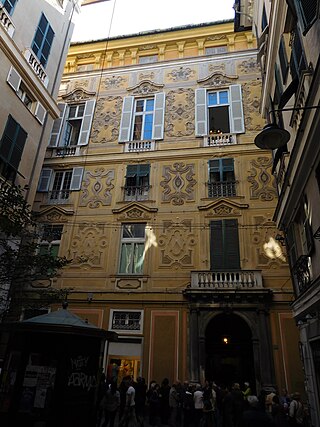
The Palazzo Nicolò Spinola di Luccoli, also called Palazzo del Marchese Stefano Franzone, or Palazzo Spinola Franzone, is a building located in Via Luccoli at number 23, in the area of the Soziglia Market in the historic centre of Genoa. The building was included in the list of palaces inscribed in the Rolli di Genova. The architecture, the decoration of the façade and the frescoes by Domenico Parodi in some of the interior rooms make it a relevant example of Genoese Baroque.

The Palazzo della Nuova Borsa Valori is a historical building in Genoa, located in Piazza De Ferrari, also known as the Palazzo della Borsa. Built by engineers Dario Carbone and Amedeo Pieragostini, its architecture recalls the Neo-16th century style, while the interiors, by Adolfo Coppedè, are inspired by the Liberty style.





















